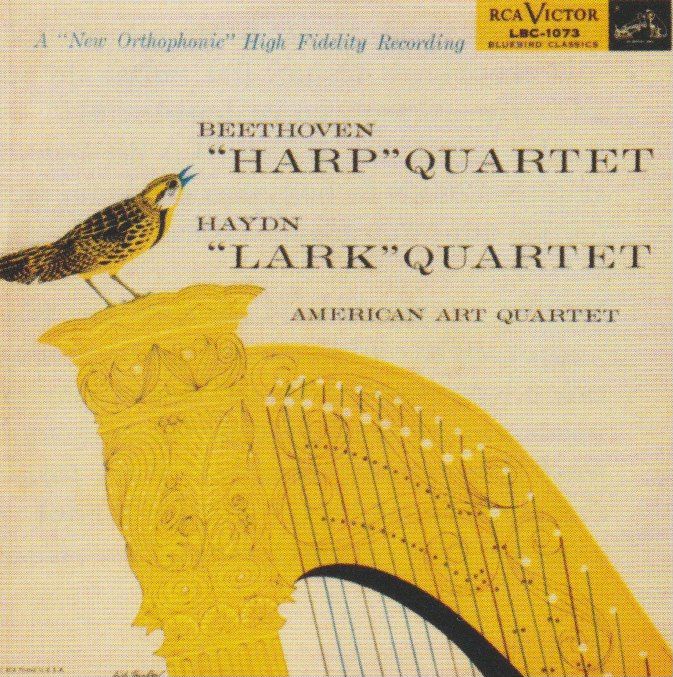American Art Quartet plays Haydn, Mozart & Beethoven
Wonderful performances, beautifully remastered and presented, with highly informative booklet notes from Tully Potter

Some chamber music for a Sunday!
Part of a renaissance of string quartets in the USA after World War II, the American Art Quartet was based in California. All four members performed in the Hollywood studios, which perhaps partly explains the freshness of the readings! (aother famed quartet that did the same was the aptly named Hollywood String Quartet). The pay the studios could afford bagged them the finest players.
The members of the quartet were first violinist Eudice Shapiro (a student of the great Efrem Zimbalist at the Curtis Institute and the first woman to lead a Hollywood orchestra); the cellist Victor Gottlieb, her husband and fellow Curtis attendee (studying with the equally great Felix Salmond); violist Virginia Majewski, and second violin Robert Suchel.
While the American Art Quartet set down recordings of fascinating repertoire by Lukas Foss, Leon Kirchner (his string quartets are amazing - post-Schoenbergian) and Ernst Toch. Their entire collection of music from the Classical period can be set down on one compact disc, however - et voilà (or is that "Et viola"?) - here they are.
The American Art Quartet started giving concerts in 1943, but only took its name in 1945.
The Haydn is a joy. It is the so-called "Lark" Quartet, recorded in 1955 and first issued, along with the Beethoven Op. 74 here, on RCA Victor LBC 1073. Listen to the glories ofthe first movement. The grasp of Haydn's structure is perfect. The nickname comes about because of the first violin's soaring E-string melody:
But it is in the profundity of the slow movement that we really feel the players getting to grips with music that is so dear to them:
There is such character to the Menuetto, but the high virtuosity of teh finale takes some beating:
The most famous recording here is surely that of the Mozart Clarinet Quintet in A, K 581 with Benny Goodman - who, we shouldn't forget, had premiered both Bartók's Contrasts and the Copland Clarinet Concerto. This Mozart, priginally released on Columbia and recorded on January 4, 1951, is a triumph. Listen to the exquisitely sculpted melody of the Larghetto:
Biddulph has a deserved reputation for fine historical transfers, but it has outdone itself in this Mozart: the clarity and presence in this Larghetto is remarkable. The finale is a set of variations, and how the players here revel in the sense of adventure, the sheer joy of the closing pages striding at us across the decades:
As we saw above, Beethoven's String Quartet in E flat was the Haydn's LP partner on Columbia LBC 1073.

The Op. 74 Quartet is called the "Harp" Quartet, and the original Columbia LP sleeve (reproduced, along with that of the Goodman sleeve, on the booklet back cover and shown above) is a drawing of a harp with a lark atop, singing. They don't make 'em like they used to.
The Quartet Op. 74 was written in 1809, and its nickcname somes from Beethoven's pizzicato writing in the first movement. We are firmly in Beethoven's "middle period"; only the F-Minor, Op. 85, stands between it and the late period works. The first movement is filled with exuberance; there's also a terseness of writing that is magnificent. We hear Beethoven's greatness, and we also hear how the American Art Quartet changes its approach, and sound, to each piece:
The intensity of the slow movement (Adagio ma non troppo) is remarkable (and there's another example of that "harp" effect):
The performane of the Scherzo is remarkable - overflowing with manic energy. . As marked it's a proper Presto:
The performance of the finale, an Allegretto con variazioni, is masterful, perfectly paced so that the final flurry of activity followed by a cadential shrug fits (so often in performance this passage can sound like a sudden spurt to the finsihing line!):
Wonderful performances, beautifully remastered and presented, with highly informative booklet notes from Tully Potter.
